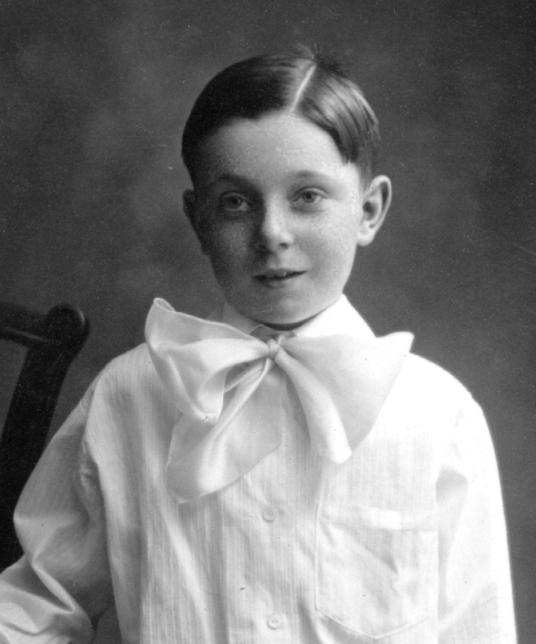
Eton Collar Neckwear: Floppy Bows

Figure 1.--This American boy was photographed around 1910, perhaps as late as 1915. He has a razor sharp hair part and wears a plain shirt waist with a detachable Eton collar and floppy bow. I'm not not positive about the color of the bow, but it looks to be white. Note that the bow is not tied as "fully" as in the past and that there appears to be only one tail--perhaps the other is obscured under the wing of the knot.
|
|
The floppy bow was particularly popular in America and to a lesser extent in France. While the Eton collar was most popular in England, we note relatively few boys there wearing their Eton collars with large floppy bows. The bows could be quite large, but not nearly as large as the huge bows that American boys might wear with a Fauntleroy suit and lace collar. The floppy bows worn with Eton collars were often tied or knotted differently than those worn with Fautleroy suits. We notice this style appearing in America around the turn of the 20th century. Floppy bows had at that time been worn for more than two decades, but had not generally been paired with Eton collars. This fashion of wearing floppy bows appears to have been popular for only about a decade, because by the 1910s floppy bows began declining in popularity in America--especially the larger ones. We note that by 1910 that the bows do not seem to be tied so ekaborately and with the pinache of th 1880s and 90s. Patterened bows are also less common. It was mostly younger boys who wore floppy bows with Eton collars, but we have noted boys as old as 12-13 years so atired.
Conventions
Eton collars like lace and ruffled collars could be worn without bows. We note large numbers of portraits showing boys wearing Eton collars both with and without bows.
Chronology
We notice this style appearing in America around the turn of the 20th century. Floppy bows had at that time been worn for more than two decades, but had not generally been paired with Eton collars. This fashion of wearing floppy bows appears to have been popular for only about a decade, because by the 1910s floppy bows began declining in popularity in America--especially the larger ones. We note that by 1910 that the bows do not seem to be tied so elaborately and with the pinache of th 1880s and 90s.
Country
The floppy bow was particularly popular in America. A good example is an American boy about 1890. Floppy bows also seem popular in France. While the Eton collar was most popular in England, we note relatively few boys there wearing their Eton collars with large floppy bows.
Sizes
The bows could be quite large, but not nearly as large as the huge bows that American boys might wear with a Fauntleroy suit and lace collar.
Tie/Knot
The floppy bows worn with Eton collars were often tied or knotted differently than those worn with Fautleroy suits.
Color/Patten
Patterened bows are also less common.
Age
It was mostly younger boys who wore floppy bows with Eton collars, but we have noted boys as old as 12-13 years so atired. Often younger boys would wear lace collars or ruffled collars and then switch to Eton collars as they got a little older. This night vary widely chronologically and at the disgression of the boy's mother. We have noted quite young boys wearing Eton collars. These younger boys usually wore their Eton collars with floppy bows, but we have noted boys as old as 10 or even older also wearing floppy bows with their Eton collars.
We also notice boys weaing Eton collars with many other types of neckwear.
Many boys' outfits had collars which could be worn with or without bows. The bow not being an integral element of the outfit. Often it was up to the mother's disgression as to add a bow or not. Other styles required large floppy bows. As the century progressed open collars disappeared and collars were increasingly worn with bows--in some cases very large floppy bows. The Fauntleroy suit was commonly worn with a large collar, often with a suitably large floppy bow added. Some smaller bows were also worn, but many mothers chose the larger size. Hre we will discuss some of the different collar styles commnly worn with bows.
HBC

Navigate the Historic Boys' Clothing Web Site:
[Return to the Main Eton collar neckwear page]
[Return to the Main collar page]
[Return to the Main Eton suit page]
[Introduction]
[Activities]
[Biographies]
[Chronologies]
[Contributions]
[Countries]
[Photography]
[Style Index]
[Bibliographies]
[Contributions]
[FAQs]
[Glossaries]
[Satellite sites]
[Tools]
[Boys' Clothing Home]
Navigate the Historic Boys' Clothing Web chronological pages:
[The 1840s]
[The 1850s]
[The 1860s]
[The 1870s]
[The 1880s]
[The 1890s]
[The 1900s]
[The 1910s]
[The 1920s]
[The 1930s]
[The 1940s]
Navigate the Historic Boys' Clothing Web style pages:
[Long pants]
[Knickers]
[Short pants]
[Scottish kilts]
[School uniform]
[Sailor suits]
[Eton style]
[Ring bearer/page costumes]
[First communion]
Created: April 18, 2002
Last updated: 5:03 AM 1/27/2007



